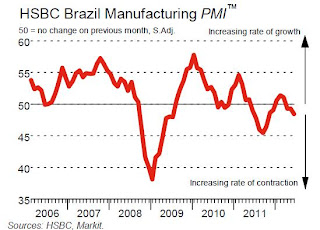IS GLOBAL RECESSION ALREADY HERE BY PMI COUNT?
A technical term that has frequently flashed out by media
reports of late is Purchasing Managers’ Index, or PMI in abbreviation.
The reports generally refer PMI scores of a region or
country to infer whether its economy is improving or otherwise. They refer to
the set benchmark of 50 points – above
50 indicates there is expansion and below 50 signals contraction. But apart
from mere general descriptions, not many people really comprehend the
mechanisms of PMI.
PMI data are the results derived from surveys conducted with
relevant parties in supply management and purchasing professions. The Institute
for Supply Management (ISM), founded in 1915, is the key organization for
compiling PMI findings for the US. It releases regular reports at the beginning
of each month. For PMI outside the US,
Markit Group is the predominant source. Other similar operators are, for
example, IFO in Germany, Bank of Japan, the Chinese Government (PMI for China).
While Manufacturing PMI is mainly perused to gauge the
sentiments of the manufacturing sector, it is also perceived as reflection of
the overall economic standing. The logical premise is that if manufacturing is
expanding, the economy at large should also trend likewise. Many economists
closely watch PMI scores to forecast their GDP growth estimates.
An index of above 50 represents
that the sector in question is expanding compared to previous month. The
50-point mark depicts the neutral level, i.e. no change from the previous
month. The pace of expansion can also be recognised by comparing with previous
month’s score. If the current figure above 50 is higher than previous month’s,
also above 50, that means expansion is at a faster rate. Conversely, if the expansion
figure is lower than previous month’s, we could interpret that the economy is
growing at a slower rate.
PMI is a composite of five (5) key sub-indicators, viz.
·
New orders from customers.
·
Production level.
·
Employment level.
·
Supplier deliveries.
·
Inventories.
Higher weightage is accorded to new orders because this
sub-indicator relates most to economic agility levels.
Now, let’s look at some latest PMI scores of various
significant economies.
- US Manufacturing ISM : heads into contraction
US
Services ISM: expansion trend lower.
Now, we turn to Europe power house: Germany and France
·
Germany Manufacturing PMI: Sharpest drop in new export orders since
November 2011.
- Germany Services PMI: Contracts
France Manufacturing PMI:
Contracts at fast rate
(Above: France Services PMI: Outstanding business fell for 6th successive month in June)
Next, we have Asia power house : China
China Manufacturing PMI: New orders fell to greatest extent in 7 months.
Here come the “rising stars” Indonesia and Brazil :
Indonesia PMI: Is very weak
·
(Above: Brazil
Manufacturing PMI: Output and new orders both decline at strongest
rates in eight months)
Look at India and Russia. You can see where the graphs are
heading to. Slowdown in expansion appears to be the trend.
Japan. A quote extracted from Reuters’
report is good indication of the scenario there: “The Markit/JMMA Japan
Manufacturing PMI fell in July to a seasonally adjusted 47.9 from 49.9 in June.
More worringly, 47.9 suggested the sector that includes the likes of camera
maker Canon Inc and carmaker Nissan Motor Corp is contracting at the fastest
pace since April 2011, a month after the earthquake and tsunami……….”
Finally, the Global Manufacturing PMI graph below denotes a
sharp declining dip to contraction in the past quarter.
Having observed the various PMIs, do you feel global
recession has already seeped in? To me, they are tell-tale signs of economic
activity sluggishness or doldrums being experienced by the globe at large……..at
least for another 1-2 years. Some may
call such a situation as economic slump, some may call it recession.
Perhaps, the “5 Reasons Why A Global Recession Seems Likely”
extracted from a Forbe’s article, posted in June, 2012, may supplement more
light:
*Europe, the world’s largest economic bloc, is already
contracting at an accelerating pace.
*China is slowing and is unlikely to be as strong a driver
of global growth as it was just a couple years ago.
*India and Brazil, two extremely important emerging powers,
also are slowing.
*The US economy, although still growing for the moment,
cannot achieve “escape velocity”, the necessary growth to produce a
self-sustaining recovery.
*The half-life on monetary bailouts is getting shorter and
shorter.
I leave to you to form your own opinion.
(Note of appreciation to my friend Chan Cheh Shin for
providing me some inputs)















